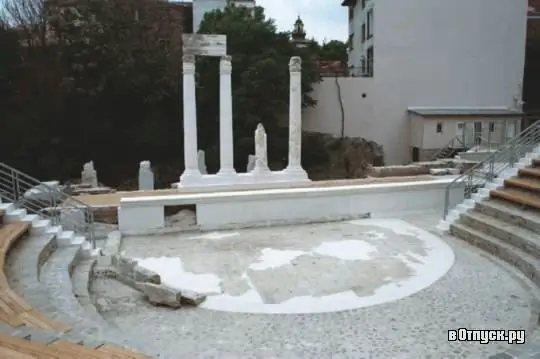
Description of the attraction
In the Bulgarian Plovdiv, in the north of the old city, there are the ruins of the ancient stadium Filipopolis. It was erected during the reign of the Roman Emperor Hadrian at the beginning of the second century. In 1923, the stadium was excavated. The visible part of the sports facility - the sphedona - is located on Dzhumaya Square, and the main part lies under Alexander Batenberg Street, the main pedestrian street of the Old City. The main entrance to the stadium is located on Kamenitsa Square.
The dimensions of the antique stadium are 240 meters long, about 50 meters wide. Monolithic blocks of marble were used to erect 14 rows of spectator seats, which could accommodate about 30 thousand people. Places for guests of honor were signed, like the tradition of the Odeon and the Ancient Theater. Today, the partially restored northern edge of the stadium and part of the fortress wall (2-4 centuries) are accessible for viewing. The ancient stadium in Plovdiv was built according to the plan of the Delphic Stadium; only 12 sports facilities of this type have survived all over the world.
Sports competitions were organized at the stadium, as well as gladiatorial fights. Gladiators fought with animals and among themselves. Sports competitions similar to the Greek games were called Piti, in 214, when Emperor Caracal visited, the games were called Alexandria, and in 218, when Emperor Elagabal visited the stadium, Kendrisia. The Games were organized by the General Assembly of the Thracian Province. For the games, special coins were minted, which depicted scenes of competitions between athletes, as well as the faces of the emperors who ruled in certain periods. Many of these coins were found during the excavations of the ancient stadium; they are included in the exposition of the Sofia Historical Museum.
Today, the ancient Roman stadium is being reconstructed under a special program implemented by the Plovdiv government with financial support from the European Union. In 1995, this site was declared a national treasure.
In addition, there are several interesting tourist sites near the stadium: at the central entrance, the remains of a city clock working on a hydraulic mechanism were found, next to it there is a memorial plate informing that in 1980 on its way from Athens towards Moscow there was one night here. there was the Olympic flame.






